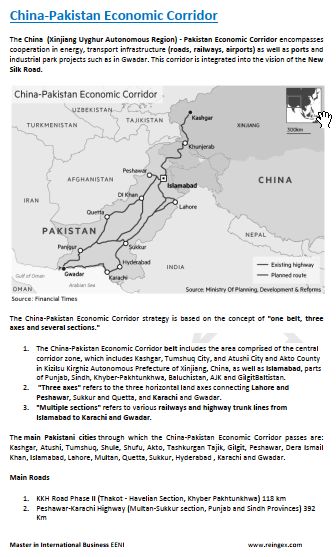China-Pakistan Economic Corridor, Islamabad

Silk Road: China-Pakistan Economic Corridor, Tajikistan Kyrgyzstan
- Introduction to the Economic Corridor China-Pakistan
- Main features of the Economic Corridor China (Xinjiang Uyghur Autonomous Region)-Pakistan
- Long-term plan for the China-Pakistan economic corridor (2017-2030)
- The China-Pakistan Economic Corridor: a key project of the New Silk Road
- China-Pakistan Agreement
- Countries in the corridor's area of influence: Afghanistan, Kazakhstan, Tajikistan.
- Impact of the China-Pakistan Economic Corridor in India, Iran and the countries of the GCC


The Subject «China-Pakistan Economic Corridor» belongs to the following Online Programs taught by EENI Global Business School:
Transportation Courses: Road, Railway, Air, Multimodal.

Diploma: International Transport.

Masters: International Transport, International Business.
Doctorate: Global Logistics, World Trade.
Languages:  .
Summary in
.
Summary in  Corredor China-Pakistán
Corredor China-Pakistán
 Corridor Chine-Pakistan
Corridor Chine-Pakistan  Corredor China-Paquistão.
Corredor China-Paquistão.
Sample - China-Pakistan Economic Corridor

The China (Xinjiang Uyghur Autonomous Region) - Pakistan Economic Corridor encompasses cooperation in energy, transport infrastructure (roads, railways, airports) as well as ports and industrial park projects such as in Gwadar. This corridor is integrated into the vision of the New Silk Road.
In the long term, the Corridor also include: agriculture, industries, tourism, human resources and financial cooperation.
The China-Pakistan Economic Corridor strategy is based on the concept of "one belt, three axes and several sections."
- The China-Pakistan Economic Corridor belt includes the area comprised of the central corridor zone, which includes Kashgar, Tumshuq City, and Atushi City and Akto County in Kizilsu Kirghiz Autonomous Prefecture of Xinjiang, China, as well as Islamabad, parts of Punjab, Sindh, Khyber-Pakhtunkhwa, Baluchistan, AJK and GilgitBaltistan
- "Three axes" refers to the three horizontal land axes connecting Lahore and Peshawar, Sukkur and Quetta, and Karachi and Gwadar
- "Multiple sections" refers to various railways and highway trunk lines from Islamabad to Karachi and Gwadar
The main Pakistani cities through which the China-Pakistan Economic Corridor passes are: Kashgar, Atushi, Tumshuq, Shule, Shufu, Akto, Tashkurgan Tajik, Gilgit, Peshawar, Dera Ismail Khan, Islamabad, Lahore, Multan, Quetta, Sukkur, Hyderabad, Karachi and Gwadar.
Main Roads:
- KKH Road Phase II (Thakot - Havelian Section, Khyber Pakhtunkhwa) 118 km
- Peshawar-Karachi Highway (Multan-Sukkur section, Punjab and Sindh Provinces) 392 Km
- Khuzdar-Basima Highway N-30 110 km
- Improvement of the D.I.Khan (Yarik) - Zhob road, N-50 Phase-I. 210 km
- KKH Thakot-Raikot N35 road, 136 km)
Railway projects:
- Expansion and reconstruction of the existing ML-1 line (1,830 km)
- Havelian Dry Harbor (450M twenty foot equivalent units)
Countries in the area of influence of the China-Pakistan Economic Corridor:
The China-Pakistan Economic Corridor will not only benefit China and Pakistan, but will have a positive impact on:
- Afghanistan
- Tajikistan
- Kyrgyzstan
- Other Central Asian countries: Kazakhstan, Turkmenistan and Uzbekistan
- Iran
- India
The China-Pakistan Economic Corridor will significantly improve China's ability to expand its economic and strategic relations with the countries of the Middle East, especially with the member countries of the GCC: Bahrain, Kuwait, Oman, Qatar, Saudi Arabia, and the Emirates.
Asian regional economic communities related to the China-Pakistan Economic Corridor
Countries of influence of the Corridor: China, Pakistan, Afghanistan, Tajikistan, Kyrgyzstan, Kazakhstan, Turkmenistan, Uzbekistan, Iran, India.
- ACU: Bangladesh, Bhutan, India, Iran, Myanmar, Maldives, Nepal, Pakistan and Sri Lanka
- CAREC: Afghanistan, Azerbaijan, China, Kazakhstan, Kyrgyzstan, Mongolia, Pakistan, Tajikistan, Turkmenistan and Uzbekistan
- China is a member of:
- SCO: Kazakhstan, China, Kyrgyzstan, Russia, Tajikistan and Uzbekistan
- EAEU: Armenia, Belarus, Kazakhstan, Kyrgyzstan and Russia
- Economic Cooperation Organization (OCE): Afghanistan, Azerbaijan, Iran, Kazakhstan, Kyrgyzstan, Pakistan, Tajikistan, Turkey, Turkmenistan and Uzbekistan
- CEI: Armenia, Azerbaijan, Belarus, Kazakhstan, Kyrgyzstan, Moldova, Russia, Ukraine, Tajikistan, Turkmenistan and Uzbekistan
- Cooperation Council of Turkic Speaking States: Azerbaijan, Kazakhstan, Kyrgyzstan and Turkey
- OSJD: Azerbaijan, Albania, Afghanistan, Belarus, Bulgaria, Hungary, Vietnam, Georgia, Iran, Kazakhstan, China, North Korea, South Korea, Cuba, Kyrgyzstan, Latvia, Lithuania, Moldova, Mongolia, Poland, Russia, Romania, Slovakia, Tajikistan, Turkmenistan, Uzbekistan, Ukraine, Czech Republic and Estonia
Related Trade Agreements
- Pakistan
- Preferential Trade Area with Mauritius
- ASEAN-Pakistan Free-Trade Area
- Trade Agreements with Sri Lanka, India, China, Bangladesh and the MERCOSUR
- Iran-Pakistan Preferential Trade Agreement
- China
- Trade Agreements with ASEAN, Singapore, Pakistan, New Zealand, Peru, Chile, the EU, Andean Community..
- Kazakhstan
- Customs Union with Russia and Belarus
- Trade Agreements with Armenia, Ukraine, Georgia and the EU
- Kyrgyzstan
- Trade Agreements with Armenia, Moldova, Ukraine, Pakistan and Uzbekistan
- Tajikistan
- Trade Agreements with Armenia, Ukraine and with the Eurasian Economic Union
- Turkmenistan
- Trade Agreements with Armenia, Georgia and with the Eurasian Economic Union
- Uzbekistan
- Trade Agreements with Kyrgyzstan, Ukraine, Georgia and with the Eurasian Economic Union
- Asia-Pacific Trade Agreement: Bangladesh, China, India, Mongolia and Sri Lanka
- Islamic Trade Preferential System (OCI-TPS)
Main Asian institutions related to the Corridor
- Boao Forum for Asia
- Asia Cooperation Dialogue
- ESCAP
- Asian Development Bank
- Colombo Plan
Main Islamic institutions
- OCI
- Islamic Development Bank
The main Religions of the region of the China-Pakistan Economic Corridor are:
The China-Pakistan Economic Corridor belongs to:
- Central Eurasian Economic Area
- Sinic Economic Area
- Bangladesh-Myanmar Corridor
- India-Afghanistan Corridor
- Asia-Africa Corridor
- China-Central-Western-Asia Corridor
- Almaty-Bishkek Corridor
- North-South Corridor (India-Russia)
- Trans-Siberian Railway (Russia, North Korea)
- Nanning-Singapore Corridor
- China-Russia Corridor
- Corridor of the Ashgabat Agreement
- Afghanistan-Turkey Corridor
- China-Central-Western-Asia Corridor
- Kyrgyzstan-Iran Corridor
- Islamabad-Istanbul Corridor
- Trans-Caspian Corridor
- Europe-Caucasus-Asia Corridor

(c) EENI Global Business School (1995-2024)
We do not use cookies
Top of this page



